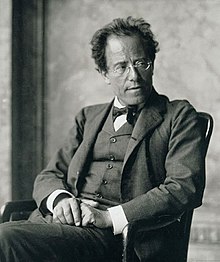Symphony No. 6 (Mahler)
| Symphony No. 6 | |
|---|---|
| by Gustav Mahler | |

Gustav Mahler in 1907
|
|
| Key | A minor |
| Composed | 1903–1904: Maiernigg |
| Published |
1906
|
| Recorded | F. Charles Adler, Vienna Symphony Orchestra, 1952 |
| Movements | 4 |
| Premiere | |
| Date | 27 May 1906 |
| Location | Essen |
| Conductor | Gustav Mahler |
Symphony No. 6 in A minor by Gustav Mahler is a symphony in four movements, composed in 1903 and 1904 (revised 1906; scoring repeatedly revised). Mahler conducted the work's first performance at the Saalbau concert hall in Essen on May 27, 1906. It is sometimes referred to by the nickname Tragische ("Tragic"). Mahler composed the symphony at what was apparently an exceptionally happy time in his life, as he had married Alma Schindler in 1902, and during the course of the work's composition his second daughter was born. This contrasts with the tragic, even nihilistic, ending of No. 6. Both Alban Berg and Anton Webern praised the work when they first heard it. Berg expressed his opinion of the stature of this symphony in a 1908 letter to Webern:
"Es gibt doch nur eine VI. trotz der Pastorale." (There is only one Sixth, despite the Pastoral.)
The symphony is written for a large orchestra comprising:
As in many other of his compositions, Mahler indicates in several places that extra instruments should be added, including two or more celestas "if possible", "several" triangles at the end of the first movement, doubled snare drum (side drum) in certain passages, and in one place in the fourth movement "several" cymbals. While at the beginning of each movement Mahler calls for two harps, at one point in the Andante he calls for "several", and at one point in the Scherzo he writes "4 harps". Often he does not specify a set number, especially in the last movement, simply writing "harps".
While the first version of the score included "whip" or slapstick and tambourine, these were removed over the course of Mahler's extensive revisions.
The status of the symphony's nickname is problematic. Mahler did not title the symphony when he composed it, or at its first performance or first publication. When he allowed Richard Specht to analyse the work and Alexander von Zemlinsky to arrange the symphony, he did not authorize any sort of nickname for the symphony. He had, as well, decisively rejected and disavowed the titles (and programmes) of his earlier symphonies by 1900. Only the words "Sechste Sinfonie" appeared on the programme for the performance in Munich on November 8, 1906. Nor does the word Tragische appear on any of the scores that published (first edition, 1906; revised edition, 1906), in Specht's officially approved Thematische Führer ('thematic guide') or on Zemlinsky's piano duet transcription (1906). By contrast, in his Gustav Mahler memoir, Bruno Walter claimed that "Mahler called [the work] his Tragic Symphony". Additionally, the programme for the first Vienna performance (January 4, 1907) refers to the work as "Sechste Sinfonie (Tragische)".
...
Wikipedia
